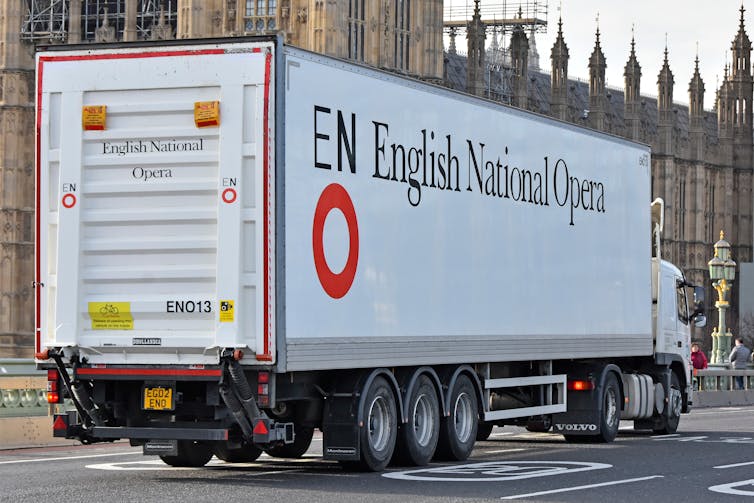
Questions about the politics of support for the arts have always been fraught and the recent announcement about Arts Council England’s latest funding round is no exception. At the heart of the current controversy is the movement of millions of pounds away from key London organisations to the regions. This move was ordered by former culture secretary Nadine Dorries in the name of “levelling up”, which was a Conservative election promise to spread economic opportunity across the country.
Among the high-profile organisations losing out are the Royal Opera House, the National Theatre and the Southbank Centre. The English National Opera will lose its annual grant and instead receive support to relocate outside the capital. Mayor of London, Sadiq Kahn, summarised the alarm at this development:
Many of our world-leading cultural organisations will be left devastated by this announcement of over £50 million worth of government cuts to London’s arts funding … These cuts could not have come at a worse time as arts organisations already face a triple whammy of spiralling operating costs, soaring energy bills and the impact of both the pandemic and the cost of living crisis on audience figures.
Support for regional bodies is welcome, even as cuts to longstanding cultural powerhouses are distressing. But viewing the process as a zero-sum game pits different parts of the country against one another. This approach also glosses over the underlying politics of arts funding beyond the number crunching and broader questions of what it’s actually for.
Social good or money maker?
Notably, those critiquing and those in support of the re-deployment of resources away from London – and, indeed, the logic of culture as an engine for “levelling up” – often rest on arguments about the economic value of culture. For instance, claims that culture contributes to urban regeneration and cultural exports boost national revenues.
Other considerations, though, have historically informed the political impetus for supporting the arts.
The roots of the current Arts Council, for instance, lie in the second world war Council for the Encouragement of Music and the Arts. The council was designed to boost morale as part of the war effort and preserve the “highest standards in the arts of music, drama and painting”. This led to the formation of the Arts Council of Great Britain in 1946, chaired by the economist and doyen of state intervention, John Maynard Keynes.
Since its initial emphasis on “excellence” and close association with “crown jewel” organisations like the Royal Opera House, the council has adopted a more egalitarian view. This includes fostering a diversity of artistic practices that represent different cultural backgrounds, as well as different tastes.
The contrasting objectives of “excellence” and “diversity” still maintain the need to support activity that might not otherwise fare well in the rough and tumble of the marketplace. However, there has been a longstanding tension in cultural policy as the emphasis has shifted inexorably from culture to the “creative industries”, which has a wider remit that includes digital businesses.
The breakup of the Arts Council of Great Britain in 1994 into funders for the constituent nations of the UK was accompanied by this broader policy shift towards the “creative industries”. There has been a closer focus on investment and revenues. Additionally, there has sometimes been ambiguity over whether the support of “creative industries” is the job of arts or business government bodies.
Increasing the burden on the arts
None of this is to say that there isn’t a solid economic case to be made for funding the arts. Rather, it’s important to highlight the long-term risks of ignoring why arts and culture can contribute to society beyond local regeneration and lining government coffers. For instance, the capacity in arts and culture for community building and personal enrichment that draw in audiences in the first place.
In this wider view, it isn’t a question of whether the English National Opera resides in London or Manchester, but how the arts are viewed as a good in themselves. It’s also about where they fit within the broader portfolio of a government’s responsibilities to its citizens.

There is a role for culture in the broader goal of “levelling up”. Venues need to be maintained and improved to attract larger audiences and investment nationwide. But putting the logistical onus of “levelling up” through culture on the Arts Council leaves it, as chair Sir Nicholas Serota noted, in the difficult position where it will have to make unpopular and divisive choices.
It isn’t clear, given the bigger historical picture, that “levelling up” the regions should fall to an already depleted central culture budget, which also has to cope with urgent matters like the ongoing fall-out of the pandemic on the arts.
There are enduring questions, for example, about how far the state should prioritise the established centres for culture and the diversity of communities engaged in creative work. These questions are difficult to resolve and adding the burden of regional disparity to the equation amid a shrinking pot for all involved has only exacerbated these issues.
Adam Behr has received funding from the Arts and Humanities Research Council and the British Academy.
This article was originally published on The Conversation. Read the original article.






